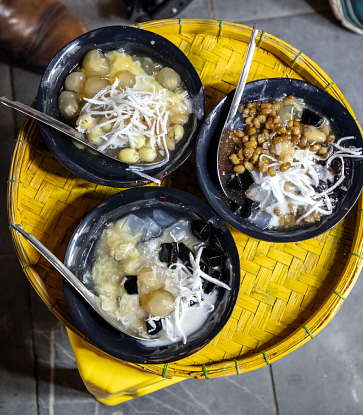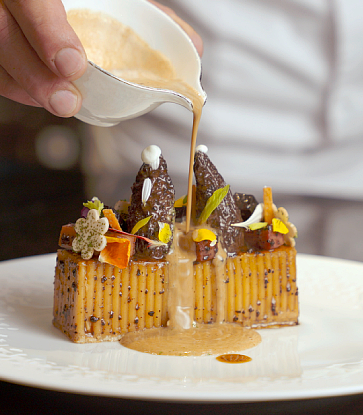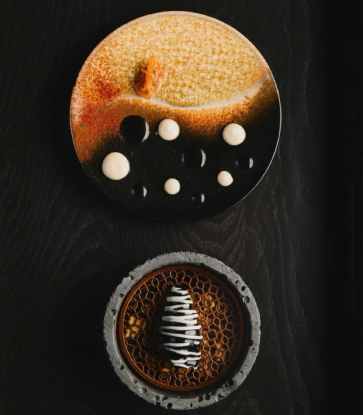Ensconced in an alleyway in Ho Chi Minh City’s District 1, Nén Light, MICHELIN Guide Hanoi and Ho Chi Minh City 2023, feels a world apart from the roaring streets of Vietnam’s biggest metropolis. Swarming around the restaurant are motorbikes and cars that ceaselessly tear through the city, but nestled within sit curious diners contemplating their spotlighted plates. There’s a lot to take in before taking that first bite.
The atmosphere is relaxed and pensive as the diners chatter over the creations in front of them, rather like people at an art gallery. Indeed, Summer Le, the founder and executive chef of Nén Light, a MICHELIN-recommended restaurant, talks about her restaurant in the same way an artist might describe an exhibition opening.

Shedding light
“The name [of the restaurant] is very important as it conveys our values,” explains Chef Le. Nén is a herb native to central Vietnam, where she is originally from, while “the word ‘light’ perfectly represents what we believe in – to look for beauty past the physical form.”“But it’s also because we want to shed new light on Vietnamese cuisine,” she continues.
Chef Le is one of a number of young Vietnamese chefs who are innovating to broaden their country’s culinary landscape. Vietnam is a diverse country with a long and storied history, evidenced by the depth of the food culture. “We are blessed to inherit a good foundation when it comes to food,” says Chef Le. “It’s now our responsibility to build on that foundation.”
But how to coherently connect the recipes of the past with the innovations of the future? For Chef Le, storytelling is key, and this is reflected in Nén Light’s flagship seven-to-nine-course tasting menus, called Sto:ry Menus.
In Sto:ry Menu #4 – Origins, which ran from November 2022, Chef Le and her team explored what it is to be Vietnamese and why it matters moving forward. Inspired by the Vietnamese saying “betel starts the conversation”, the menu begins with a dish that uses betel leaf and areca nut, which older Vietnamese people, typically women, have been chewing for thousands of years. “It turned out to be one of our defining dishes,” remembers Chef Le, despite it using ingredients that, these days, most Vietnamese people eschew (rather than chew).
In Sto:ry Menu #5 – Days of 22, which launched in October 2023, diners embark on a journey of impassioned youth, inspired in part by Chef Le’s time spent in Japan as an undergraduate student immediately after high school. The first canopé is a playful “Origami Airplane”, evoking a one-way ticket to foreign lands. A king oyster mushroom base represents the clouds while an edible paper-like plane soars above. “Every creative product needs a story,” says Chef Le.

Reimagining traditional recipes
A few kilometres from Nén Light and across the Sài Gòn River in District 2, creativity also abounds at Tre Dining, a MICHELIN-listed restaurant from the MICHELIN Guide Hanoi and Ho Chi Minh City 2023. Here, diners sit mere metres from a team of chefs in an open-plan setting and under a latticed bamboo ceiling. The team works their culinary wizardry for all the restaurant to see, as they conjure dishes that reimagine traditional recipes with contemporary techniques and flair.“We aimed to create a space that not only celebrated the diversity of Vietnamese cuisine,” says Luu Dong, head chef of Tre Dining when talking about the conceptualisation process, “but also offered a platform for creativity and experimentation.”
The à la carte menu is speckled with the most successful results of those experiments. For example, the Cà Mau Crab uses molecular gastronomy techniques to deconstruct and reconstruct a dish with a prized ingredient from the south of the Mekong Delta region with coix seeds, sea urchins, and wild scampi caviar. A new dish on the menu embellishes phở, Vietnam’s national noodle soup usually served with only chicken or beef, with sliced veal and charcoaled foie gras. In a playful take on a Southeast Asian sweet snack, Chef Dong has substituted creamy risotto rice for sticky rice and paired it with mango and coconut. This makes the dessert lighter while retaining the traditional trio of flavours.
The tasting menus, such as the nine-course The Reborn menu, seems to feature an even more daring sequence of flavours. “We aim to reimagine traditional Vietnamese dishes by infusing them with innovative culinary approaches, creating exciting and unexpected flavour combinations,” says Chef Dong. “We aim to surprise and delight our guests with each menu.”
Among these flavour combinations are pork paired with cassava and coconut, sweetbread tempura with ant egg salt and lime leaf, and a fish donut with chocolate truffle and Vietnamese coffee ice cream.

Global ambitions
While Chef Le and Chef Dong are plotting separate paths in modernising Vietnam’s culinary landscape, both are challenging the boundaries that frame how their native cuisine is traditionally understood. They also both agree that the future of Vietnamese cuisine looks bright – and increasingly global.“Vietnam's modern cuisine offers the world a unique combination of rich traditions, diverse flavours, and a commitment to sustainable and locally sourced ingredients,” opines Chef Dong of Tre Dining. “[This makes it] a cultural and culinary treasure that has much to offer global gastronomy.”
“I want to build a Vietnamese food brand that can go global,” dreams Chef Le, who feels that street food should not be the only image that comes to mind when thinking about her country’s cuisine. “That’s something we need in Vietnam. Something that can take our stories and our cuisine to the rest of the world.”
While young Vietnamese chefs reshape their culinary legacy, Visa leads the way in uniting worldwide food lovers communities through digital payments. With a presence in more than 200 countries and territories, the brand offers innovative, convenient, reliable, and secure payment options, empowering individuals, businesses, and economies to prosper. Their belief in an inclusive economy that elevates everyone, everywhere underscores the importance of access in shaping the future of businesses and financial transactions.
Illustration image: © Nén Light, Tre Dining






















